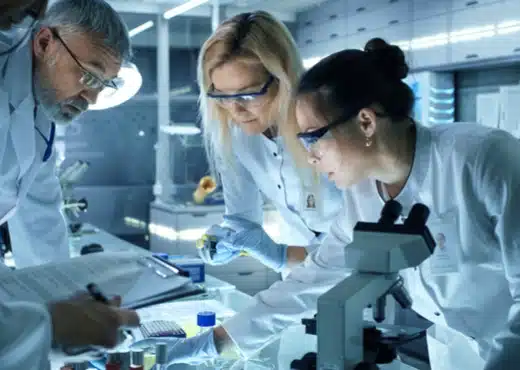Uterine fibroids are frequently seen in the later reproductive years, especially during a woman’s 30s and 40s.1 These noncancerous tumors may not be an issue, but they can be the cause of serious symptoms, such as pelvic pain, heavy periods, and urinary frequency. For many of these women, finding a cure that also preserves fertility is important. A recent study found that uterine fibroid embolization (UFE)—an effective minimally invasive treatment—doesn’t impact ovarian reserve in women younger than 40 years as once believed but instead may be considered an option without concern for it negatively affecting fertility.2
Click here to watch how ufe treats fibroids.
The study, published in Minimally Invasive Therapy & Allied Technologies, discussed the effects of ufe on ovarian reserve as measured by Anti-Müllerian hormone (amh) levels—a marker that reflects ovarian reserve or the ovaries’ ability to produce good-quality eggs.2 Diminished amh, and thereby ovarian reserve, is believed to be a cause of infertility.
Earlier research suggested that ufe caused diminished amh levels and shouldn’t be performed on women who want children.3 But this finding was based on data collected from women who were of an average age of 45—relatively older in comparison to many women who desire future pregnancy.
“We studied women under the age of 40,” says Bruce McLucas, MD, board certified gynecologist, founder of Fibroid Treatment Collective, a medical group of fibroid experts dedicated to curing fibroids with minimally invasive therapy, and the study’s lead author. “Over the age of 40, statistically, it’s more likely that any number of factors could impact infertility.” Factors, according to Dr. McLucas, include anovulatory cycles and diminished egg quality—both of which can happen with age and negatively affect fertility.
Dr. McLucas and his team observed 89 women aged 23-40 years who underwent ufe for treatment of symptomatic fibroids.2 Hormone levels were measured before and after the procedure. Results confirmed that amh levels decreased with age but that ufe didn’t contribute to this natural decline. Thirty-two patients consented to multiple blood draws over the course of almost four years post-ufe. The researchers found that ufe didn’t negatively affect ovarian reserve over the long term.
“We controlled for the fact that, for example, at age 30 a woman’s amh levels are going to be higher than at 32 and so on,” Dr. McLucas. “We looked at the age patients had ufe and then again years later. According to initial pre-ufe amh levels, after the procedure we saw a falloff that continued through all the premenopausal years. Overall our data showed a decline that reflected somebody who had not had ufe.”
This was the case for over 60% (54 patients) of the women who participated in the study.2 An even bigger finding was that amh levels actually increased in 36% (32 patients) of the women tested. amh levels remained unchanged in the remaining 3% (3 patients).
“The fact that amh levels increased in a third of patients, despite the tendency for those people to have a lower amh with age, is really a very positive finding,” Dr. McLucas tells Ask4 ufe. “In our patient population, there was a lot more variability than we thought for any age.”
For younger patients, under the age of 40, ufe may be an effective option because the procedure shrinks fibroids that could otherwise be responsible for pregnancy complications, such as premature birth and increased risk of caesarian section.
“The uterus survives ufe because of collateral circulation,” says Dr. McLucas. “Even though the vessels that feed the fibroids are treated, there are plenty of other blood vessels that supply the uterus that aren’t affected. Leaving the uterus intact allows many women to have a vaginal delivery.” Almost half (48%) of women in the study became pregnant, with most carrying to term and delivering healthy babies.2
For women in their 40s, ufe can still effectively treat fibroids, but research shows there’s a risk (7%) of premature menopause. Of these women who lost menstruation, 86% were older than 45. “This occurrence doesn’t seem to affect the younger population,” Dr. McLucas continues. “As a woman approaches menopause, the ovarian blood supply becomes more fragile. Everyone is different. In our practice, nobody under the age of 46 has had a cessation of menses after ufe.”
This advantage may prove to be an asset for younger women who aren’t quite ready to start a family but need fibroid symptom relief. “These are the women who I think benefit the most from ufe,” Dr. McLucas says. “After myomectomy, doctors tell patients the traditional golden period to try and get pregnant is within six months. Wait any longer than that, and you run the risk of new fibroids growing. ufe offers long-term relief from severe symptoms. Women often wait as long as five or six years to have a pregnancy after ufe and without any fibroid regrowth.”
Research in favor of ufe’s ability to treat symptoms and preserve fertility is growing. This is another advancement in women’s health that moves us in the direction of better fibroid care.
ABOUT THE DOCTOR Bruce McLucas, MD is a board-certified gynecologist and founder of Fibroid Treatment Collective, a medical group of fibroid experts dedicated to curing fibroids with minimally invasive therapy. Fibroid Treatment Collective was the first group to perform ufe in the U.S., and Dr. McLucas was the first OB/GYN qualified to perform ufe nationally. Since then he’s performed over 8,000 ufe procedures and has dedicated much of his career to ufe education and outreach. Dr. McLucas trains other doctors in ufe and lectures around the globe.
REFERENCES
- S. Department of Health & Human Services, Office on Women’s Health. (2018, Mar 16). Uterine fibroids. https://www.womenshealth.gov/a-z-topics/uterine-fibroids
- McLucas, B., Voorhees, W. D., & Snyder, S. A. (2018). Anti-Müllerian hormone levels before and after uterine artery embolization. Minim Invasive There Allied Technol, Jun;27(3):186-190.
- Tulandi, T., Sammour, A., Valenti, D., et al. (2002). Ovarian reserve after uterine artery embolization for leiomyomata. Fertil Steril, Jul;78(1):197-198.







